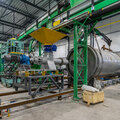The pervasive use of plastics in our daily lives has led to a global plastic waste crisis. Addressing this issue requires innovative and sustainable approaches to manage plastic waste and reduce its environmental impact. One such solution is the conversion of plastic waste into pyrolysis oil. In this comprehensive post, we will delve into the key features of plastic to pyrolysis oil conversion, exploring the process, its environmental benefits, applications, and the role it plays in the transition to a more sustainable and circular economy.
The Plastic Waste Challenge
The proliferation of plastics has revolutionized various industries and improved our quality of life. However, it has also given rise to a significant environmental challenge. Single-use plastics, packaging materials, and other plastic products contribute to pollution, habitat destruction, and pose risks to human and wildlife health.

The key issues associated with plastic waste include:
Long Decomposition Time: Plastics can persist in the environment for hundreds of years, with many plastic items taking centuries to break down. Apply plastic pyrolysis plant for sale to make pyrolysis oil.
Environmental Pollution: Improper disposal of plastics leads to visual pollution, contamination of ecosystems, and the release of microplastics into the environment.
Resource Depletion: The production of plastic is resource-intensive, relying on finite fossil fuels, and contributing to greenhouse gas emissions.
Landfills and Incineration: The disposal of plastic waste in landfills and incineration facilities has its own environmental challenges, including soil and air pollution.
The Promise of Pyrolysis
Pyrolysis is a thermochemical process that can transform plastic waste into valuable products, including pyrolysis oil. The process entails heating plastic waste in the absence of oxygen, causing it to break down into oil, gas, and solid residues. The pyrolysis oil produced is a versatile and sustainable product that has gained recognition as a viable solution for plastic waste management. Here are the key features of plastic to pyrolysis oil conversion:
Environmental Benefits of Pyrolysis Oil
Converting plastic waste into pyrolysis oil offers several environmental benefits:
a. Waste Reduction: Pyrolysis reduces the volume of plastic waste, helping to minimize the environmental burden of plastic pollution.
b. Resource Conservation: By recycling plastics into pyrolysis oil, we conserve the valuable resources used in plastic production, such as crude oil.
c. Energy Recovery: Pyrolysis oil can be used as a renewable energy source, either directly or after further refining. This reduces reliance on fossil fuels and lowers greenhouse gas emissions.
d. Mitigation of Greenhouse Gas Emissions: The process of pyrolysis locks carbon in the form of pyrolysis oil, preventing it from being released into the atmosphere as CO2. This contributes to the reduction of greenhouse gas emissions.
e. Reduction of Microplastics: Pyrolysis effectively breaks down plastics, preventing the formation of microplastics that can persist in the environment.

The Pyrolysis Process
To better understand the key features of plastic to pyrolysis oil conversion, let's explore the pyrolysis process in more detail:
a. Feedstock Preparation: The first step involves collecting and preparing plastic waste. Common feedstocks for pyrolysis include plastic bags, bottles, containers, and other plastic products.
b. Heating in the Absence of Oxygen: The prepared plastic waste is introduced into a pyrolysis reactor, which is heated to a specific temperature (usually around 400-800°C) in the absence of oxygen. This prevents combustion and the formation of harmful emissions.
c. Decomposition: The plastic waste undergoes thermal decomposition, breaking down into pyrolysis oil, gases, and solid residues. The gases produced may include hydrocarbons and other volatile compounds.
d. Cooling and Collection: The resulting pyrolysis oil is cooled and collected. It can be further refined to meet specific requirements, depending on its intended applications.
e. Gas and Solid Residues: Gases produced during pyrolysis can be captured and used as an energy source or for other industrial processes. Solid residues, often referred to as char, can find application in various sectors, including agriculture and construction.
Versatile Applications of Pyrolysis Oil
Pyrolysis oil is a versatile product with a wide range of applications, making it a valuable resource for various industries and activities:
a. Energy Generation: Pyrolysis oil can be used as a fuel for heating or electricity generation. It is considered a renewable energy source and can replace traditional fossil fuels.
b. Industrial Processes: Industries such as metal smelting and chemical manufacturing use pyrolysis oil as a reducing agent in various processes.
c. Transportation: Pyrolysis oil can be further refined into biodiesel, a sustainable alternative to conventional diesel fuel.
d. Agriculture: Pyrolysis oil can be utilized to enhance soil quality. It improves soil structure, moisture retention, and nutrient availability, promoting better plant growth.
e. Water Purification: Activated carbon derived from pyrolysis oil can effectively remove impurities and contaminants from water, making it safe for consumption.
f. Environmental Remediation: Pyrolysis oil can be employed in the remediation of contaminated sites, helping to neutralize or remove hazardous substances.
Challenges and Considerations
While the conversion of plastic waste into pyrolysis oil offers significant benefits, it is not without challenges and considerations:
a. Feedstock Quality: The quality and composition of the plastic feedstock can influence the quality and yield of pyrolysis oil. Contaminants and impurities in the feedstock may affect the process.
b. Energy Requirements: The pyrolysis process requires significant energy input for heating, which can impact the overall environmental sustainability of the process. Efforts are ongoing to develop more energy-efficient pyrolysis technologies.
c. Emission Control: The gases produced during pyrolysis may contain pollutants, so emission control and treatment systems are necessary to prevent their release into the atmosphere.
d. Refining and Upgrading: Depending on the intended application, further refining and upgrading of pyrolysis oil may be required. This can add to the overall cost of the process.
e. Circular Economy Integration: To fully harness the potential of pyrolysis oil, it is essential to integrate it into a circular economy framework, promoting the recycling and reuse of materials.
The Road to Sustainability
The conversion of plastic waste into pyrolysis oil represents a significant step toward a more sustainable and circular economy. It addresses the plastic waste challenge by reducing environmental pollution, conserving resources, and offering renewable energy solutions. To further promote this transformative process, it is important to focus on research and development to improve pyrolysis efficiency, reduce energy requirements, and enhance the quality of pyrolysis oil. Additionally, regulatory support and incentives can encourage industries to adopt and invest in pyrolysis technologies, fostering a transition to a more sustainable and environmentally responsible future. Plastic to pyrolysis oil conversion is not just a waste management solution; it is a path towards a greener and more sustainable world.





